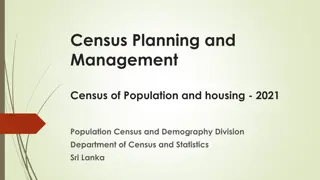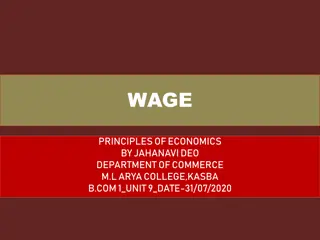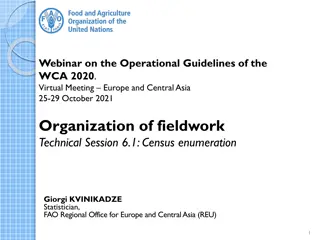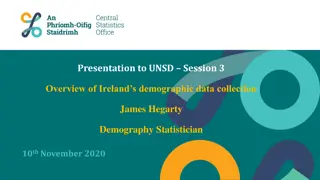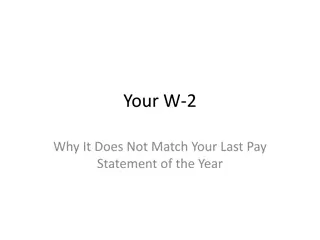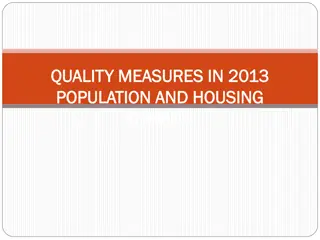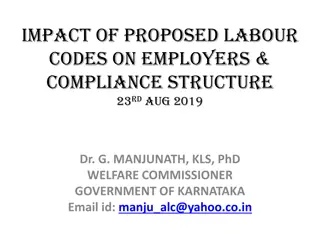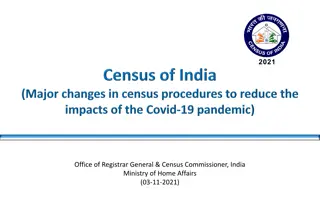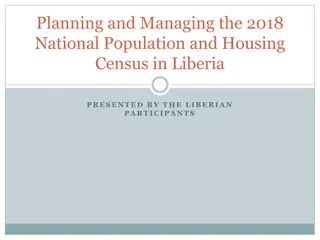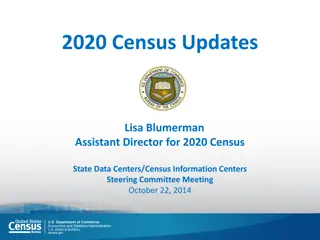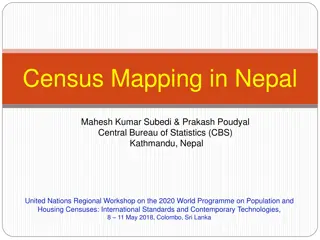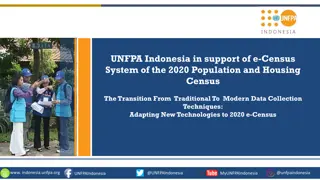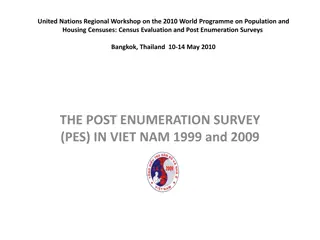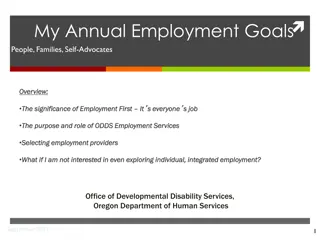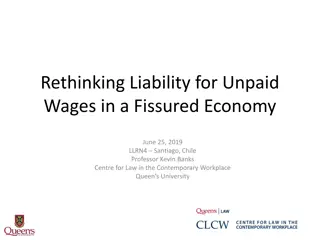Understanding Quarterly Census of Employment and Wages (QCEW) Program
The Quarterly Census of Employment and Wages (QCEW) is a collaborative program between federal and state entities that collects and disseminates employment and wage data at local levels. This program covers over 10 million establishments, offering valuable insights into employment trends and industry specifics. Data collected is used for various purposes and serves as a significant sample for BLS surveys. The Multiple Worksite Report (MWR) is a key component of QCEW, providing detailed employment and wage data for multi-establishment firms.
Download Presentation

Please find below an Image/Link to download the presentation.
The content on the website is provided AS IS for your information and personal use only. It may not be sold, licensed, or shared on other websites without obtaining consent from the author. Download presentation by click this link. If you encounter any issues during the download, it is possible that the publisher has removed the file from their server.
E N D
Presentation Transcript
Displaying Previously Reported Data to Respondents in the Quarterly Census of Employment and Wages Program at the Bureau of Labor Statistics Emily Thomas US Bureau of Labor Statistics 2021 FCSM Research and Policy Conference November 4, 2021 1 U.S. BUREAU OF LABOR STATISTICS bls.gov
Quarterly Census of Employment and Wages (QCEW) 2 U.S. BUREAUOF LABOR STATISTICS bls.gov
What is the Quarterly Census of Employment and Wages (QCEW)? QCEW is a Fed-State program that partners with Unemployment Insurance Tax departments in each state to collect and publish employment and wage information at the local County and MSA levels Publishes monthly employment and quarterly wages for over 10 million establishments covering 97% of U.S. workers. Publishes county-level summaries of monthly employment and quarterly wages by industry. 2-, 3-, 4-, 5-, and 6-digit NAICS industry detail QCEW also serves as the universe sample for BLS sample-based surveys. 3 U.S. BUREAUOF LABOR STATISTICS bls.gov 3 U.S. BUREAUOF LABOR STATISTICS bls.gov
Uses of Quarterly Census of Employment and Wages Data
Data Collection in QCEW BLS 3020 - Multiple Worksite Report (MWR) BLS 3023 Annual Refiling Survey (ARS) 5 U.S. BUREAUOF LABOR STATISTICS bls.gov 5 U.S. BUREAUOF LABOR STATISTICS bls.gov
Multiple Worksite Report (MWR) 6 U.S. BUREAUOF LABOR STATISTICS bls.gov
QCEW - MWR QCEW states receive the Quarterly Contribution Report (QCR) from UI Tax on a monthly basis. This report contains monthly employment and quarterly wages for each firm operating in the state. For single-establishment firms, this is sufficient for QCEW. For multi-establishment firms, QCEW supplements this with the Multiple Worksite Report so that we have detailed NAICS and CTY level employment and wage data. 7 U.S. BUREAUOF LABOR STATISTICS bls.gov 7 U.S. BUREAUOF LABOR STATISTICS bls.gov
Who files an MWR? Most multi-location employers with a total of 10 or more employees combined in their secondary locations are required or requested to complete the MWR. An employer's primary location is the location with the most employment in a State. All other locations within the State are secondary locations. The MWR is mandatory in 31 states 8 U.S. BUREAUOF LABOR STATISTICS bls.gov 8 U.S. BUREAUOF LABOR STATISTICS bls.gov
Why do we collect the MWR? Company ABC s UI Report -Reports E&W in CTY 123 -All E&W in retail industry Location 3 -County 333 -Manufacturing Location 2 -County 222 -Warehouse Company XYZ s UI Report -Reports E&W in CTY 789 -All E&W in retail industry Location 1 -County 111 -Manufacturing 9 U.S. BUREAUOF LABOR STATISTICS bls.gov 9 U.S. BUREAUOF LABOR STATISTICS bls.gov
Multiple Worksite Report Collected quarterly and covers: 1.5% of all employers nationwide 17% of all worksites nationwide 41% of all employment and wages nationwide 10 U.S. BUREAUOF LABOR STATISTICS bls.gov 10 U.S. BUREAUOF LABOR STATISTICS bls.gov
MWR Web The MWR Web system is prepopulated each quarter with all eligible multis in QCEW. Each individual worksite and address Reported monthly employment and quarterly wages from the prior quarter Respondents log into the web system and report current quarter employment and wages for their worksite. For existing MWR Web accounts, there is a >90% response rate each quarter. 11 U.S. BUREAUOF LABOR STATISTICS bls.gov 11 U.S. BUREAUOF LABOR STATISTICS bls.gov
MWR Web Edits Prepopulated data allow more complex, live data editing Current quarter data are compared with prior quarter for unexpected reporting patterns (Ex. Higher than expected employment or wage levels) Respondents are prompted to fix or explain anomalies (Ex. Seasonal hires, etc.) 12 U.S. BUREAUOF LABOR STATISTICS bls.gov 12 U.S. BUREAUOF LABOR STATISTICS bls.gov
MWR Web Screens 13 U.S. BUREAUOF LABOR STATISTICS bls.gov
MWR Web Screens 14 U.S. BUREAUOF LABOR STATISTICS bls.gov
MWR Web Screens 15 U.S. BUREAUOF LABOR STATISTICS bls.gov
MWR Web Screens 16 U.S. BUREAUOF LABOR STATISTICS bls.gov
MWR Web Screens 17 U.S. BUREAUOF LABOR STATISTICS bls.gov
MWR Web Screens 18 U.S. BUREAUOF LABOR STATISTICS bls.gov
Annual Refiling Survey (ARS) 19 U.S. BUREAUOF LABOR STATISTICS bls.gov
What is the ARS? The ARS makes sure the information we have on file for establishments is correct. This survey presents respondents with their current industry and location Respondents are asked to either verify that the current information is correct, or provide updated information. 20 20 U.S. BUREAUOF LABOR STATISTICS bls.gov 20 U.S. BUREAUOF LABOR STATISTICS bls.gov
Why is the ARS needed? The basis for sampling by industrial and geographic coding for CES, OES, OSHS, LAUS, MLS and BLS Wage programs is the QCEW file. INDUSTRY and GEOGRAPHIC codes in QCEW flow to many other sources and it is important that they are accurate. 21 21 U.S. BUREAUOF LABOR STATISTICS bls.gov 21 U.S. BUREAUOF LABOR STATISTICS bls.gov
ARS Identifies Multis The ARS also asks employers if they have opened up any additional locations This is a major source that QCEW uses to determine if an employer should be a multiple-establishment employer 22 22 U.S. BUREAUOF LABOR STATISTICS bls.gov 22 U.S. BUREAUOF LABOR STATISTICS bls.gov
ARS Three Year Cycle Conducted on a 3 year cycle so that 1/3 of eligible employers are selected each year Employers are selected based on the 7th and 8th digits of their EIN number Selection pattern allows an even distribution of industries, locations, and size classes each year. 23 23 U.S. BUREAUOF LABOR STATISTICS bls.gov 23 U.S. BUREAUOF LABOR STATISTICS bls.gov
Why display current information? 25+ years ago, this survey was conducted without presenting the respondent with their current information. Respondents were only asked to provide their current industry and location. Using pre-populated data reduces: Non-economic churn Respondent burden Data processing/review cost 27 27 U.S. BUREAUOF LABOR STATISTICS bls.gov 27 U.S. BUREAUOF LABOR STATISTICS bls.gov
Contact Information Emily Thomas Supervisory Economist US Bureau of Labor Statistics Quarterly Census of Employment and Wages www.bls.gov/cew Thomas.Emily@bls.gov 28 U.S. BUREAUOF LABOR STATISTICS bls.gov


